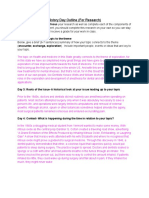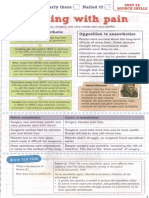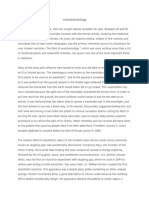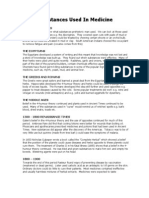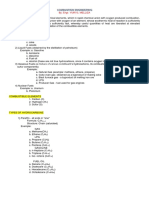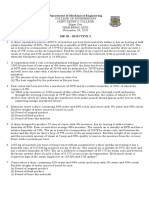Day. Date.
TED Talks
Try something new for 30 days
A few years ago, I felt like I was stuck in a rut, so I
decided to follow in the footsteps of the great
American philosopher, Morgan Spurlock, and try
something new for 30 days. The idea is actually
pretty simple. Think about something you've always
wanted to add to your life and try it for the next 30
days. It turns out 30 days is just about the right
amount of time to add a new habit or subtract a habit
-- like watching the news -- from your life.
There's a few things I le a rned while doing these 30-
d ay ch a llenges . The first w a s , inste a d of the months
fl y ing b y , forgotten, the time w a s much more
memor a ble . This w a s p a rt of a ch a llenge I did to t a ke
a picture ever y d ay for a month. And I remember
ex a ctl y where I w a s a nd wh a t I w a s doing th a t d ay . I
a lso noticed th a t a s I st a rted to do more a nd h a rder 30
- d ay ch a llenges , m y self-confidence grew. I went
from desk-dwelling computer nerd to the kind of gu y
who bikes to work. For fun!
Even l a st y e a r , I ended up hiking up Mt. Kilim a nj a ro ,
the highest mount a in in Afric a . I would never h a ve
been th a t a dventurous before I st a rted m y 30- d ay
ch a llenges .
I a lso figured out th a t if y ou re a ll y w a nt something
b a dl y enough, y ou c a n do a n y thing for 30 d ay s . H a ve
y ou ever w a nted to write a novel? Ever y November,
tens of thous a nds of people tr y to write their own 50,
000-word novel, from scr a tch , in 30 d ay s . It turns out,
a ll y ou h a ve to do is write 1,667 words a d ay for a
month. So I did. B y the w ay , the secret is not to go to
sleep until y ou 've written y our words for the d ay . You
might be sleep-deprived, but y ou 'll finish y our novel.
Now is m y book the next gre a t Americ a n novel? No. I
wrote it in a month. It's a wful .
But for the rest of m y life, if I meet John Hodgm a n a t
a TE D p a rt y , I don't h a ve to s ay , "I'm a computer
scientist . " No, no, if I w a nt to, I c a n s ay , "I'm a
novelist . "
1
�So here's one last thing I'd like to mention. I learned
that when I made small, sustainable changes, things I
could keep doing, they were more likely to stick.
There's nothing wrong with big, crazy challenges. In
fact, they're a ton of fun. But they're less likely to
stick. When I gave up sugar for 30 days, day 31
looked like this.
So here's my question to you: What are you waiting
for? I guarantee you the next 30 days are going to
pass whether you like it or not, so why not think about
something you have always wanted to try and give it a
shot! For the next 30 days.
Thanks.
2
� Day. Date.
TED Talks
What did people do before anesthesia?
With medical students restraining the patient and onlookers
eagerly awaiting, Scottish surgeon Robert Liston poised
himself to begin. In quick succession, he cut his patient’s flesh,
sawed through their tibia and fibula and, within just a few
minutes, the amputation was complete. It was the 1830s and
Liston was renowned for his surgical speed. This was
important because, before anesthesia was widely used, patients
had to consciously endure every moment of surgery.
The quest for anesthetics that could induce unconsciousness
and enable more meticulous surgeries launched long before
Liston. Around 200 CE, Chinese physician Hua Tuo described
mixing alcohol with a powder of various ingredients to
anesthetize patients. And 13th century Arab surgeon Ibn al-
Quff described patients taking anesthetics, likely inhaling
drugs like cannabis, opium, and mandrake, from saturated
sponges.
By the end of the 1700s, many scientists were pondering
chemistry’s medical applications. This led to a profusion of
anesthetic advancements involving three main players: nitrous
oxide, ether, and chloroform.
In 1799, English chemist Humphry Davy began experimenting
with nitrous oxide, or laughing gas— inhaling it himself and
observing its effects on friends. Davy noted that its pain-
relieving abilities might make it useful for surgical operations
— but it would be decades before that happened. This was, at
least in part, because some surgeons and patients were
skeptical of the effectiveness and safety of anesthetic drugs.
In 1804, Japanese surgeon Seishū Hanaoka successfully
removed a breast tumor from a patient anesthetized with a mix
of medicinal herbs. But the news stayed in Japan indefinitely.
Eventually, ether started garnering medical attention. It was first
formulated centuries before then came to be used recreationally.
During the so-called “ether frolics” of the early 1800s, an
American physician noted that the fall he suffered while using
ether was painless. In 1842, he etherized a patient and
successfully removed a tumor from his neck.
3
�In the meantime, dentists finally began recognizing nitrous
oxide’s promise. But, in 1845, when an American dentist
attempted a public tooth extraction on someone anesthetized
with nitrous oxide, he apparently encountered a setback when
his patient screamed. It was probably just an insufficient dose—
but it was a bad publicity moment for the drug.
Meanwhile, dentists refined ether for tooth extractions. And, in
October 1846, an American dentist administered ether to a
patient, and a surgeon removed the man’s neck tumor. Two
months later, Liston himself performed an upper leg amputation
on an etherized patient, who reportedly regained consciousness
minutes after and asked when the procedure would begin.
Further ether-enabled successes followed from India, Russia,
and beyond.
But ether had issues, including unpleasant side effects. Scottish
obstetrician James Simpson heard about an alternative anesthetic
called chloroform. And, in 1847, he and two colleagues decided
to try some themselves and promptly passed out. Soon after,
Simpson administered chloroform to one of his patients during
childbirth. It quickly gained popularity because it was fast-acting
and thought to be side-effect-free— though we now know it’s
harmful and probably carcinogenic.
Because anesthetics weren’t yet fully understood, they
sometimes had lethal consequences. And some doctors held
sexist and racist beliefs that dictated the amount of anesthesia
they’d provide, if any at all. American obstetrician Charles
Meigs argued that the pain of childbirth was a form of divine
suffering and was skeptical that doctors should interfere with it.
Throughout the 1840s, American physician James Marion Sims
conducted experimental gynecological surgeries without pain
relief, primarily upon enslaved Black women.
By the late 19th century, those who could access anesthetics
were undergoing increasingly complex operations, including
some that were previously impossible. Chloroform came to be
understood as a riskier, more toxic option, and fell out of favor
by the early 1900s. Alongside newer drugs, ether and nitrous
oxide are still used today— but in modified formulations that are
safer and produce fewer side effects, while doctors closely
monitor the patient’s state. Thanks to these advances, speed is
not always of the essence and, instead of acute agony, surgery
can feel like just a dream.
4
� Day. Date.
TED Talks
Is it normal to talk to yourself?
As your morning alarm blares, you mutter to yourself, “Why did
I set it so early?” While brushing your teeth, you think, “I need
a haircut... unless?” Rushing out the front door, you reach for
your keys and realize they’re not there. Frustrated you shout, “I
can’t do anything right!” just in time to notice your neighbor.
Being caught talking to yourself can feel embarrassing, and
some people even stigmatize this behavior as a sign of mental
instability. But decades of psychology research show that
talking to yourself is completely normal. In fact, most, if not all,
of us engage in some form of self-talk every single day. So why
do we talk to ourselves? And does what we say matter?
Self-talk refers to the narration inside your head, sometimes
called inner speech. It differs from mental imagery or recalling
facts and figures. Specifically, psychologists define self-talk as
verbalized thoughts directed toward yourself or some facet of
your life. This includes personal conversations like “I need to
work on my free throw.” But it also includes reflections you
have throughout the day, like “The gym is crowded tonight. I’ll
come back tomorrow.” And while most self-talk in adults tends
to be silent, speaking to yourself out loud also falls into this
category.
In fact, psychologists believe our first experiences with self-talk
are mostly vocal, as children often speak to themselves out loud
as they play. In the 1930s, Russian psychologist Lev Vygotsky
hypothesized that this kind of speech was actually key to
development. By repeating conversations they’ve had with
adults, children practice managing their behaviors and emotions
on their own. Then, as they grow older, this outward self-talk
tends to become internalized, morphing into a private inner
dialogue.
We know this internal self-talk is important, and can help you
plan, work through difficult situations, and even motivate you
throughout the day. But studying self-talk can be difficult. It
relies on study subjects clearly tracking a behavior that’s
spontaneous and often done without conscious control. For this
reason, scientists are still working to answer basic questions,
like, why do some people self-talk more than others?
5
�What areas of the brain are activated during self-talk? And
how does this activation differ from normal conversation?
One thing we know for certain, however, is that what you say
in these conversations can have real impacts on your attitude
and performance.
Engaging in self-talk that’s instructional or
motivational has been shown to increase focus, boost
self-esteem, and help tackle everyday tasks. For
example, one study of collegiate tennis players
found that incorporating instructional self-talk into
practice increased their concentration and accuracy.
And just as chatting to a friend can help decrease
stress, speaking directly to yourself may also help
you regulate your emotions. Distanced self-talk is
when you talk to yourself, as if in conversation with
another person. So, rather than “I’m going to crush
this exam,” you might think, “Caleb, you are
prepared for this test!” One study found that this
kind of self-talk was especially beneficial for
reducing stress when engaging in anxiety-inducing
tasks, such as meeting new people or public
speaking.
But where positive self-talk can help you, negative
self-talk can harm you. Most people are critical of
themselves occasionally, but when this behavior gets
too frequent or excessively negative, it can become
toxic. High levels of negative self-talk are often
predictive of anxiety in children and adults. And
those who constantly blame themselves for their
problems and ruminate on those situations typically
experience more intense feelings of depression.
Today, there’s a field of psychological treatment
called cognitive behavioral therapy, or CBT, which
is partially focused on regulating the tone of self-
talk. Cognitive behavioral therapists often teach
strategies to identify cycles of negative thoughts and
replace them with neutral or more compassionate
reflections. Over time, these tools can improve one's
mental health.
So the next time you find yourself chatting with
yourself, remember to be kind. That inner voice is a
partner you’ll be talking to for many years to come.
6
�Day. Date.
TED Talks
Title




